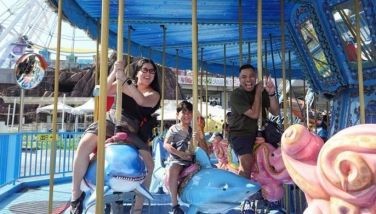The hopeful shape of the economic future

One year and a half into a six-year presidential term under the stewardship of Ferdinand Marcos, Jr., the shape of the Philippine economic future to the end of that term in 2028 is emerging.
There is much to catch up on, as the country had suffered a reversal that has taken nearly four decades to repair. Signs of an optimistic direction are in the foreseeable future.
An optimistic scenario. The annual growth rate of GDP for this year could be shaping up near six percent. Barring any catastrophic event outside of the control of the government, the plan to sustain the six percent annual growth path is possible. The government’s economic plan hopes for an even better rate of progress.
With good fortune in keeping a proper macro balancing of the fiscal front with the international payments front (that is, through the maintenance of sound macroeconomic fundamentals), it is possible to build a growth path that is sustainable at the six percent rate.
The general improvement of the overall economy is seen from the expansion of the urban landscape and the changing skyline of buildings where commerce, services, and industry are expanding. These perspective views of the urban surroundings give a picture of an economy in forward motion.
Unsightly communities that are not caught up within the ambit of progress will continue to worry many of us. As the mass base improves, in due time but not within the six-year period, the areas left behind will also be swept into the sphere of development.
(That is part of the equation of hopeful growth: not all participants in the economy move forward at the same speed. This is true among all of us: workers, businesses, communities, regions, and provinces! )
The daily traffic gridlock in the metropolis may be a cause for frustration for those living in the country’s center of gravity, which is the National Capital Region or Metro Manila.
Even as the distraction and discomfort are evident and frustrating, the signs of future improvements are all around to be seen. The structures of ongoing transport projects surround the place. The gridlock is caused by tightness of space because construction is all around us.
The general population might be living this daily inconvenience persistently. Help will come when the public transport rail lines in still unserved and underserved communities are finished. Some of these will be finished by 2028. New lines will be put under construction and, therefore, cause further discomfort. But then the residents in the areas blessed with finished transport will find improved and faster transportation for them.
These developments impart the writing-on-the wall for the jeepney form of transport in the city. When public rail lines take over the main system for moving people, the demand for short-haul transport will undergo acceleration for modernization.
A modern overhaul of it will include a mix of small modern vehicles that displace the jeepney as we know it, along with motor-tricycles, and buses. The short-haul traffic demand will continue to include heavy pedestrian traffic.
Growth in the other regions. In the meantime, growth and development in the other regions of the country has been moving forward through the decades. And this account of growth and development is linked to the present time span that we live in.
I have documented in this column some of the growth in the country’s various regions from my reports following some extensive regional travels I have made in the past.
The larger opening of the economy to the world at large has helped our own regional development. In part, this is because throughout the last few decades, many regional poles of growth have opened up in the country.
These poles of growth (Calabarzon, Central Luzon, the islands of Cebu, Panay, Negros, Leyte, and economic expansion of Mindanao along the growth experience of Cagayan-de-Oro, General Santos, and Davao) are helping to change the pattern of progress in the nation.
In part, this is due to the influence of overall national growth on the regions. Also, government policies positively affecting regions have led to more domestic industry and commerce because of their natural locations and the support of government in improving roads, ports, airports, and bridges.
The widening of national roads passing through major provinces was a major activity of the Noynoy Aquino administration. This has been an important source of easing road transport across the nation. Further, the richer provinces have also improved their network of roads with the help of the national government.
Just as important is the building of faster express-highways under toll-fee access. This development has eased the heavy outward and inward traffic into Metro Manila, especially in Luzon island. The expressway system had its origins in the 1960s, but it has gradually branched out only in recent memory.
The legacy of such improvements benefit the present administration. That is the way it should be in nation-building.
Government attention that was paid to particular strategic regions have improved the expansion of commerce and industry. These are outcomes that could be attributed to the development programs across different administrations.
In general, the Philippines now is much more connected by national roads with the help of ports and Ro-Ro vessels, major airports, and provincial airports. There is great need to modernize the interisland system of Ro-Ro vessels. The general growth of the national economy helps to strengthen the country’s economic centers of growth with the help of such investments in public infrastructure.
The dispersal of the influence of worker’s remittances from abroad and from work within the country has also helped in the flow of incomes to these regions.
Income flows in support of remittances might have help raised consumption and industry in the rural areas too. I have not seen data on remittances on a regional basis to support this statement. However, sporadic examples of housing improvements in provincial urban towns are indirect evidence of this point. Moreover, many families of workers live in the provinces where the cost of living is lower.
To be continued
- Latest
- Trending



























